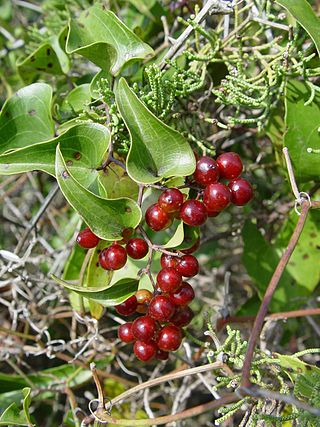
Smilacaceae, the greenbriers, is a family of flowering plants. While they were often assigned to a more broadly defined family Liliaceae, most recent botanists have accepted the two as distinct families, diverging around 55 million years ago during the Early Paleogene. One characteristic that distinguishes Smilacaceae from most of the other members of the Liliaceae-like Liliales is that it has true vessels in its conducting tissue. Another is that the veins of the leaves, between major veins, are reticulate (net-shaped), rather than parallel as in most monocots.

Smilax is a genus of about 300–350 species, found in the tropics and subtropics worldwide. They are climbing flowering plants, many of which are woody and/or thorny, in the monocotyledon family Smilacaceae, native throughout the tropical and subtropical regions of the world. Common names include catbriers, greenbriers, prickly-ivys and smilaxes. Sarsaparilla is a name used specifically for the Neotropical S. ornata as well as a catch-all term in particular for American species. Occasionally, the non-woody species such as the smooth herbaceous greenbrier are separated as genus Nemexia; they are commonly known by the rather ambiguous name carrion flowers.

Smilax ornata is a perennial trailing vine with prickly stems that is native to Mexico and Central America. Common names include sarsaparilla, Honduran sarsaparilla, and Jamaican sarsaparilla.

Smilax rotundifolia, also known as roundleaf greenbrier or common greenbrier, is a woody vine native to the southeastern and eastern United States and eastern Canada. It is a common and conspicuous part of the natural forest ecosystems in much of its native range. The leaves are glossy green, petioled, alternate, and circular to heart-shaped. They are generally 5–13 cm long. Common greenbrier climbs other plants using green tendrils growing out of the petioles.

In Classical mythology, Crocus was a mortal youth who was changed by the gods into a saffron flower.

Gracillariidae is an important family of insects in the order Lepidoptera and the principal family of leaf miners that includes several economic, horticultural or recently invasive pest species such as the horse-chestnut leaf miner, Cameraria ohridella.

Smilax herbacea, the smooth carrionflower or smooth herbaceous greenbrier, is a plant in the catbriar family. It is native to eastern Canada and the eastern United States. Its preferred natural habitat is rich forests, and riparian thicket and meadows.

Smilax glyciphylla, the sweet sarsaparilla, is a dioecious climber native to eastern Australia. It is widespread in rainforest, sclerophyll forest and woodland; mainly in coastal regions.

Smilax aspera, with common names common smilax, rough bindweed, sarsaparille, and Mediterranean smilax, is a species of flowering vine in the greenbriar family.

Smilax glauca, the cat greenbriar or catbriar is a woody vine in the family Smilacaceae. It is native to central and eastern portions of the United States as well as Mexico, where it is a common and conspicuous part of the forest vegetation.

HMS Smilax was originally launched as Tact (PG-98), an Action-class gunboat built for the United States Navy by Collingwood Shipyards, Ltd., Collingwood, Ontario, Canada
Sarsaparilla often refers to the sarsaparilla soft drink, made from Smilax plants.

Smilax bona-nox, the saw greenbrier, is a species of plant in the family Smilacaceae. It is native to the Southern United States, and eastern Mexico.

Sarsaparilla is a soft drink originally made from the vine Smilax ornata or other species of Smilax such as Smilax officinalis. In most Southeast Asian countries, it is known by the common name sarsi, and the trademarks Sarsi and Sarsae. It is similar in flavor to root beer. In the US, sarsaparilla is traditionally made with birch oil rather than the tropical plant.

Smilax aristolochiifolia, also known as gray sarsaparilla, Mexican sarsaparilla, sarsaparilla, is a species in the genus Smilax and the family Smilacaceae, native to Mexico and Central America. It is widely used as traditional medicine to treat many symptoms.

USCGC Smilax (WAGL/WLIC-315) is a 100-foot (30 m) United States Coast Guard Cosmos-class inland construction tender. Commissioned in 1944, Smilax is the "Queen of the Fleet", the oldest commissioned U.S. Coast Guard cutter.

Gracillariinae are a subfamily of moths which was described by Henry Tibbats Stainton in 1854.

Smilax tamnoides, common name bristly greenbrier, is a North American species of plants native to the United States and Canada. It is widespread from Ontario and New York State south to Texas and Florida.
In Greek mythology Smilax was the name of a nymph who was in love with Crocus and was turned into the plant bearing her name. Ancient sources with information about her and her tale are few and far between.















